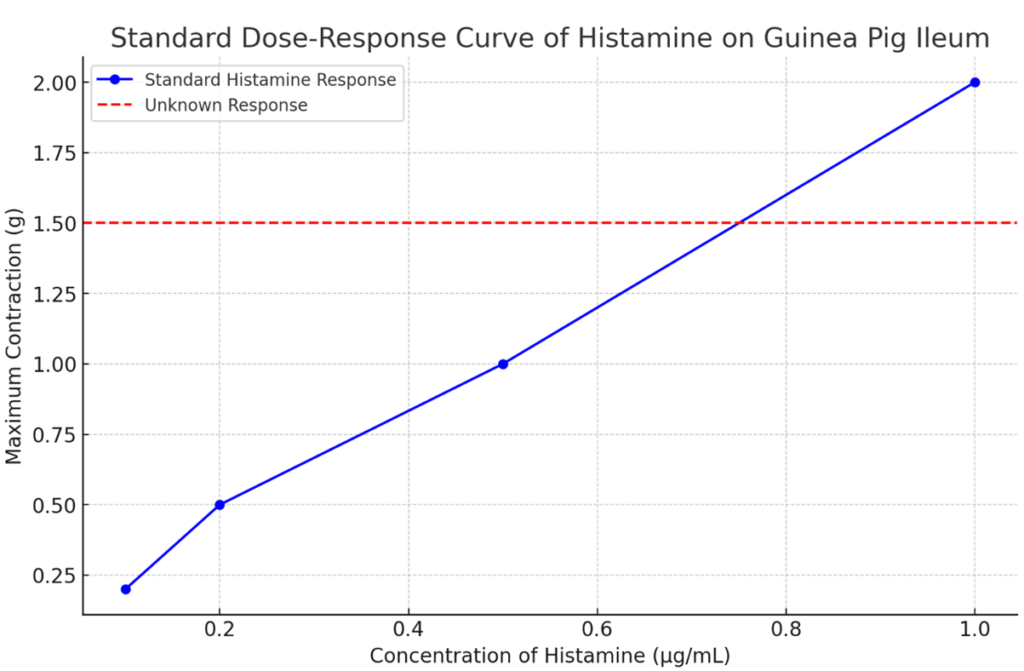Aim: Bioassay of Histamine Using Guinea Pig Ileum by Matching Method
References
1. Ghosh, M.N. (2008). Fundamentals of Experimental Pharmacology (6th ed.). Hilton & Company.
2. Rang, H.P., Dale, M.M., Ritter, J.M., & Flower, R.J. (2015). Rang & Dale’s Pharmacology (8th ed.). Churchill Livingstone.
3. Schild, H.O. (1947). The bioassay of histamine on the guinea pig ileum. British Journal of Pharmacology, 2(3), 189-195.
Introduction
Histamine is a potent agonist of H1 receptors, causing smooth muscle contraction. The guinea pig ileum is highly sensitive to histamine, making it a suitable tissue for bioassays. The matching method involves comparing the unknown concentration of histamine to a standard concentration by observing the muscle contraction.
Objective
To determine the concentration of histamine in an unknown sample using the guinea pig ileum by the matching method.
Materials and Equipment
- Guinea pigs (to isolate the ileum)
- Dissection tools (scissors, forceps, etc.)
- Physiological saline (Tyrode’s solution)
- Histamine standard solutions (known concentrations)
- Unknown histamine solution
- Tissue bath setup
- Aeration system (Oxygen supply)
- Isometric transducer or force transducer
- Recording device (kymograph or digital recorder)
- Micropipettes and tips
- Data analysis software (optional)
Procedure
1. Preparation of Guinea Pig Ileum:
- Sacrifice the guinea pig by cervical dislocation or using an appropriate anesthetic.
- Quickly dissect the abdomen and isolate a segment of the ileum (about 2-3 cm).
- Remove mesenteric attachments and mount the ileum in a tissue bath filled with Tyrode’s solution, maintained at 37°C and continuously aerated with oxygen.
2. Equilibration: Allow the ileum to equilibrate in the tissue bath for about 30 minutes, with constant aeration.
3. Baseline Recording: Record the baseline muscle tension to ensure stability and viability of the preparation.
4. Standard Histamine Response:
- Prepare standard histamine solutions of known concentrations (e.g., 0.1, 0.2, 0.5, 1.0 µg/mL).
- Add the lowest concentration of histamine to the tissue bath and allow the ileum to contract.
- Record the maximum contraction.
- Wash the ileum with fresh Tyrode’s solution and allow it to return to baseline tension.
- Repeat the process for each standard concentration and plot the dose-response curve.
5. Testing Unknown Histamine Solution:
- Add the unknown histamine solution to the tissue bath and allow the ileum to contract.
- Record the maximum contraction.
- Compare the contraction response to the standard histamine dose-response curve to estimate the concentration of the unknown solution.
6. Matching Method:
- Identify the standard concentration of histamine that produces a contraction matching that of the unknown solution.
- Use this matching concentration to determine the concentration of histamine in the unknown sample.
Data Analysis
1. Plotting Standard Dose-Response Curve: Plot the maximum contraction (response) on the y-axis against the concentration of histamine on the x-axis for the standard solutions.
2. Determining Unknown Concentration:
- Locate the response produced by the unknown histamine solution on the y-axis.
- Draw a horizontal line from this point to intersect the standard dose-response curve.
- From the intersection point, draw a vertical line down to the x-axis to determine the concentration of histamine in the unknown sample.

The blue line represents the response of the tissue to known concentrations of histamine. The red dashed line indicates the unknown response, which can be matched to the standard curve to determine the concentration of histamine in the unknown sample.
Sample Data Table
| Histamine Concentration (µg/mL) | Maximum Contraction (g) |
| 0.1 | 0.2 |
| 0.2 | 0.5 |
| 0.5 | 1.0 |
| 1.0 | 2.0 |
| Unknown | 1.5 |
Sample Plot
To visualize the data, plot the dose-response curve using the sample data provided. The unknown concentration can be identified by matching the response.
